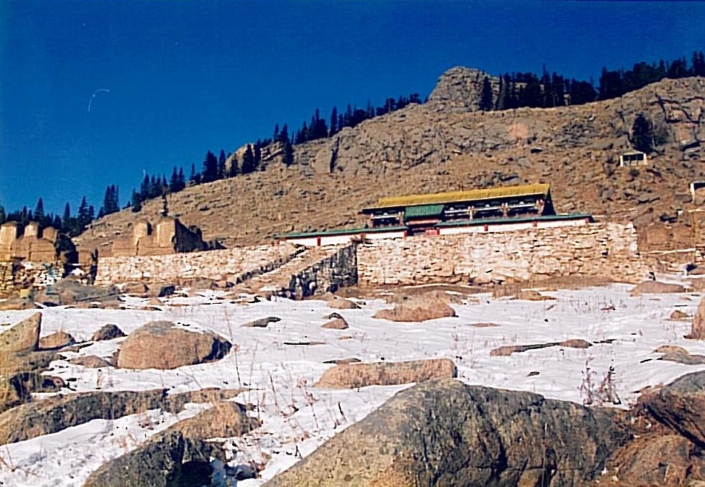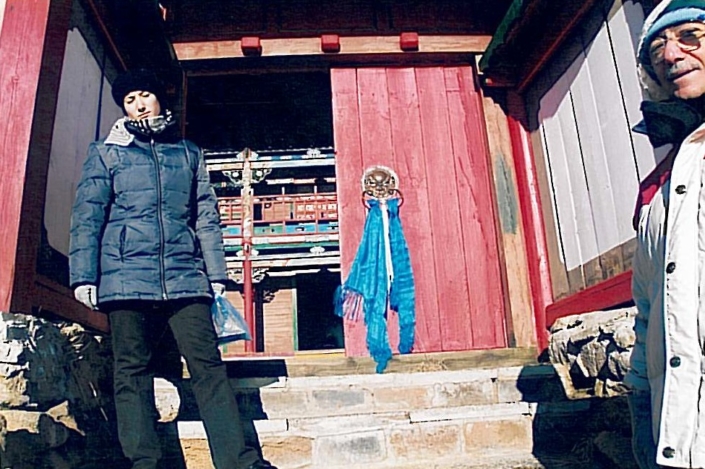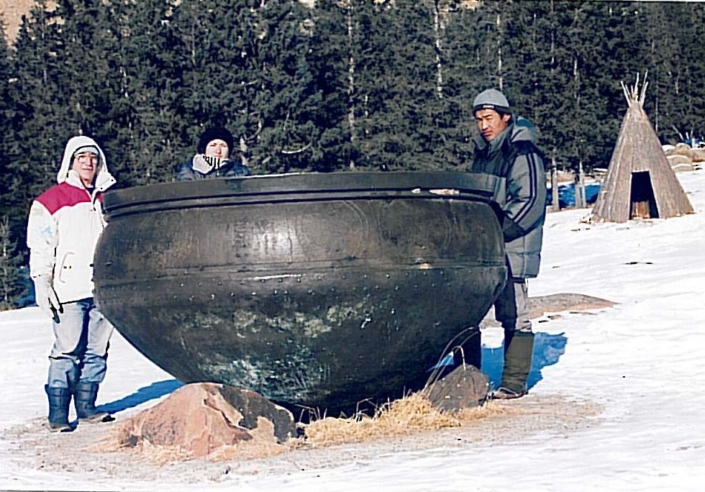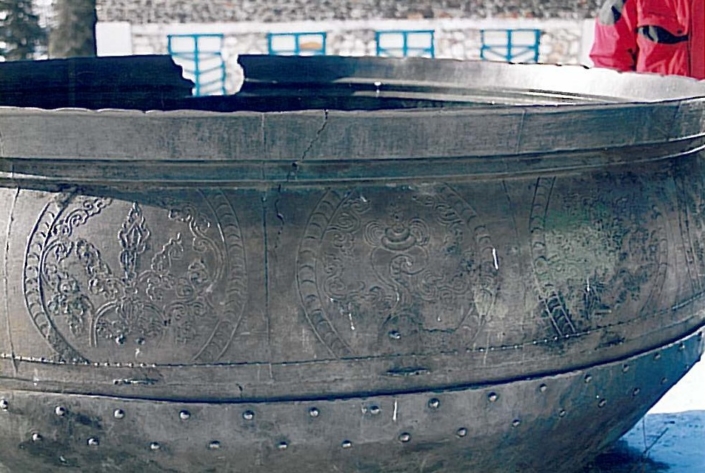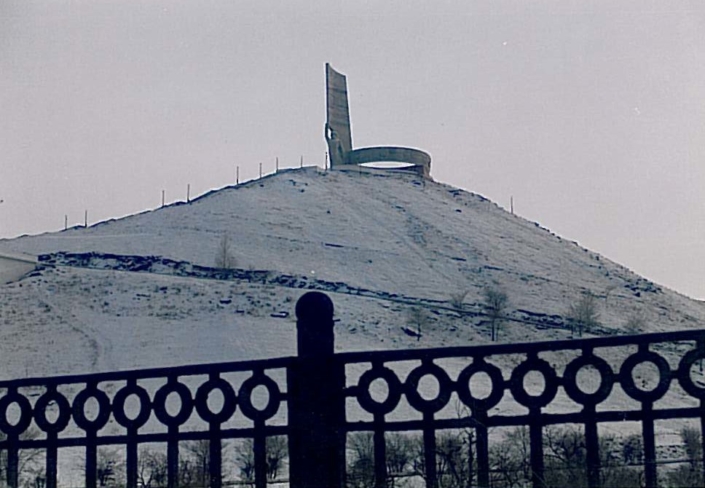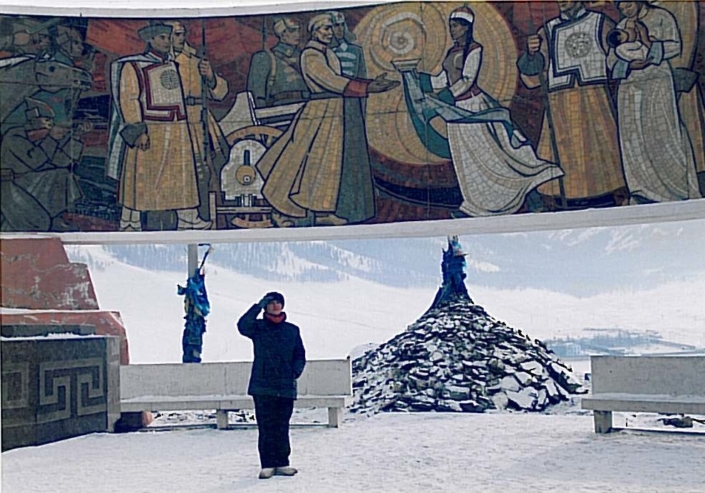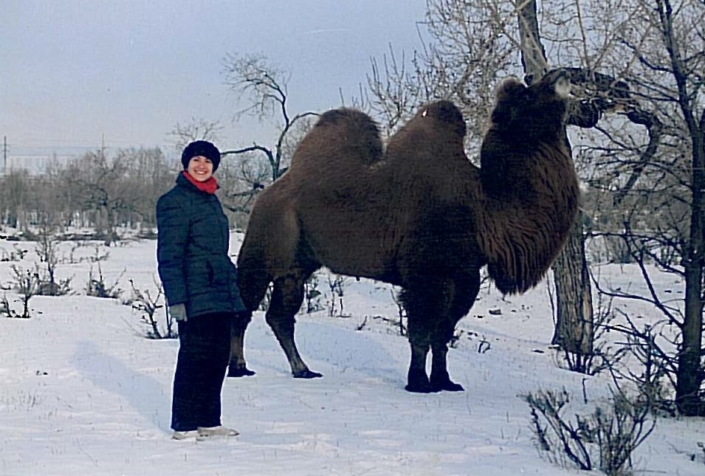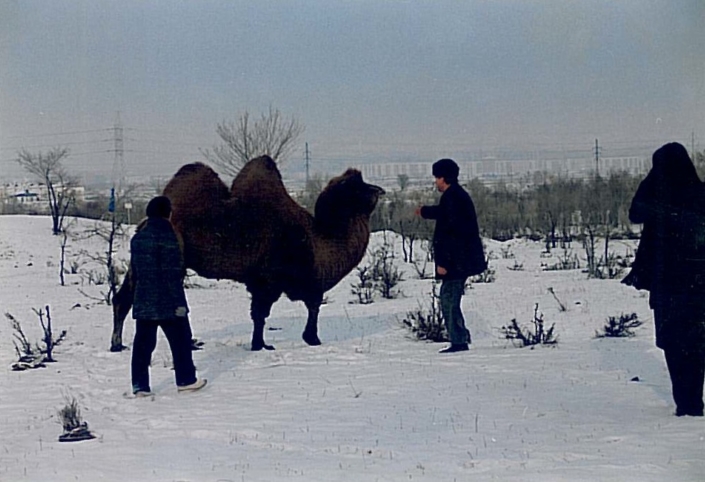Mongolian Weekly News no. 8 – The Final Episode!
Date: January 10, 2000
Dear Friends,
Greetings to everybody once again, with one last cyber-newsletter before I fly back to Ankara via Moscow next Sunday. The MWC is quite a bit longer, in the effort not to leave anything left unsaid that could or should be said about this Mongolian experience, additional commentary.
I’m intending to turn this into a website for wider dissemination, if I can manage, in Turkey. An upcoming scanner purchase will add photos, hopefully, so they can tell a thousand words more, each. I can’t predict the pace of life back in Turkey but I definitely will try.
So, Ramadan is over. We’ve experienced it quite intensively here, as an official post, with some invitations held and attended. For the New Year, the Embassy staff gathered for a toast in the dining room, coinciding with fasting time, thus some staff not being able to toast the champagne with the rest. The toast was immediately before iftar , the breaking of fast around 17:30; it was nonetheless bearable. By the way, I fasted too (one day- wow)! First time in 12 years! I guess at this rate it will be every 12 years, guessing from my age being 24… There was some slightly acidic stomach activity (sorry for the graphic description!) toward the end and a calmness taking over after a while. I was also proud of being able to wake up on time for sahur, the meal eaten just before sunrise, around 6 am. This has been a real problem here- the late sleeping and waking hours. Every day for me is like a Sunday morning after a Saturday night of hard partying- and half a day feels like it is wasted. An illusion, since a nocturnal life makes up for the lost morning hours. Can a jet lag continue so long? My mother says she never fully recovered either… Anyone with advice or stories? At the end, I’ve stopped trying, and will adjust back in the final destination in Turkey. The religious holiday (Bayram) was welcomed on Saturday with an invitation for representatives of Turkish schoolteachers in the country. Last time, for the beginning of the Ramadan month, it was all women and this time all men- mostly their spouses. As far as I know, this is a coincidence, definitely not gender segregation on our part. I felt uneasy about it a little, but the presence of Mrs Y and a female staff member, as well Miss Y, eased the awkwardness.
Ramadan in Mongolia is also significant for the Muslim Kazakhs, living mostly in the western aimag of Bayan-Olgii. To answer, what is an aimag, this is the name for each of the eighteen provinces of the country, further divided into 298 districts (sums). There are four independent municipalities as well, sort of like the Unitary authorities in the UK, e.g. City of York, or the Greater Municipalities in Turkey like Ankara, Istanbul or Izmir.
Last Tuesday, the IWAM (women’s association) general meeting was held at the German Embassy, which provided the venue this time. Different places take turns like this for every event. (Like the New Year tea at our place and the diplomatic New Year in the Bulgarian Embassy, where some beautiful murals in the main hall depicted medieval Byzantine icon style pictures of Bulgarian history, triggering discussions on history and enlightening us about the source of the Cyrillic alphabet. Two brothers, Cyril and Methodius introduced the script.) Over this IWAM GM, my mother presided, and I went to watch and support her. The event was full of interesting things like the lecture on Russian cuisine, with an accompanying food treat (super!), and on Russian Christmas and Epiphany, why they are on different dates (it had to do with pre-Christian traditions being carried over and linked to the new faith, and the interpretation of Christ’s birth date, as far as I understood) and the roots of the food and festivity culture in the pagan and earth-bound customs of the Russian people. The guests who came that day make their own introductions, including myself, so it was a participatory environment. The introduction of Bernard Rubinstein of the Santa Fe Opera visiting from the US was another colourful feature. Mr. Rubinstein came to conduct Porgy and Bess with the Mongolian National Opera- an interesting combination! They are dealing with legal complications, as George Gershwin’s estate forbids anyone but an African-American ensemble to play the opera. They will probably do a concert version at this rate. In the meeting, products were brought in by various people, like a blind people centre (we bought a garishly golden pillow altruistically), a painter with his cloth paintings, and a German volunteer bringing Kazakh wall hangings. I meanwhile socialized with the daughter of a Japanese Embassy officer, and her friend, speaking about our countries, tourism, jobs and Mongolia.
During the meeting, the UK Ambassadress, a warm lady, invited my family to the Steppe Inn (or is it Step In?), an invitation that we took up. It was a British Embassy communal hangout with expats gathering Friday nights to hang out for two hours. There I met a Patrick, South African- Irish gentleman helping the National University of Mongolia with administrative development, and it look like I’ll be introducing the University of York and METU (in Ankara) to some people in the NUM this week. Fingers crossed!..
Last Sunday, we took our weekend excursion to Manzshir, a natural reserve of some kind, containing some small temple and wildlife museums, ancient statues and a ger camp, as well as a ruin of an adobe temple, this and the well-kept, brightly coloured wooden temple museum adjacent to it, located within a hillside temple site. An uphill trek on our part led us to the site, and a look around in the cold slope resulted in me running back down the hill in desperate intent of reaching the car. Running and thumping feet on the ground a good measure against frostbite pain, for future reference. We bought small pictures as souvenirs at the hillside temple; the museum guard was also the painter of the works, selling her own stuff. The museum only opened when visitors came. We bought the pictures as a kind of fee for the visit, as there was none- they could really exploit their museum revenue potential a bit more; it is likely to come along in the future.
Today’s outing to Bayangol, a valley site of Russian dachas (holiday cottages) also revealed a potential for the future, as a cross-country skiing track. We walked along a narrow path lined with trees, ovoo on the way, and covered with soft snow, perfect for skiing; we saw a group later who had set out do just that, and felt tempted to do the same. Upon return to the city, we decided to take a look at the Zaisan Memorial to unknown soldiers and heroes built by the Russians. The freezing, biting cold was so bad after the balmy valley an hour ago, that my father’s eyeglass lenses got covered with icicles. The resident camel around the area near the base of the monument hill overlooking the city was well-equipped against this cold though, as it was the furriest, most well-groomed camel I ever saw. Apparently, it was the ‘pet’ of some Americans, who then left UB and left the camel to a caretaker here. Bizarre…
The ‘today’ of yesterday became the ‘yesterday’ of today, by the way…
As for today’s ‘today’, we have just come back from an exhibition opening in the Artists’ Union locale, and man, was there a CROWD. The Mongolian Scramble (see later for explanation) was a bit more artistically subdued there, but still we had our share. It seemed to be connected with a fine arts education institute, judging from the proportion of young people, probably students, and elderlies treated like maestros and speaking in front of TV cams. The paintings were all abstract and modern, though ethnic, folkloric themes were visible in almost all. The post-Communist explosion of free artistic expression, especially that of ethnic culture, doesn’t seem to near being over… So yet another one of our UB days was filled with a weird and wonderful event.
Now, it is time for the Nine Questions directed to me by Seigneur Andrew from Amsterdam. I am glad the Mongolian account has triggered such a curiosity for Andrew and İffet to ask many essential questions. I even looked at an Amsterdam article on the Web’s Travel Lifeminders, of Yahoo!, to see how a travel or city writer describes a city and people and for a few tips to brush off. On the Qs…
1- What would European tourists find interesting in UB and Mongolia?
As sightseeing places, my own recommendations from first-hand experience and second-hand knowledge would be Karakurum, Erdene Zu monastery and the Turkic Orkhun monuments; the Khovsgol Lake to the north of the country famous for its scenery and unspoilt wildlife; the Gobi Desert to the south; the UB area with the monasteries and museums, and the surrounding sites like Terelj, Bayangol and Manzshir (most of the places I mentioned before, basically, plus a few more). The Lonely Planet recommends different itineraries for: 1- Hitchhiking (Kharkhorin; the thermal springs town of Khujirt; Delgerkhaan, where the ancient city of Avarga is claimed to be Chinggis Khan’s capital instead of Karakurum and which the LP labels as a place of Chinggis-mania; and the large cities of Erdenet and Darkhan) 2- Jeep (many possible routes, but with a good driver) 3- Horse (short trip around UB; or a trek between Tsetserleg, a pleasant town in central Arkhangai aimag, and Khujirt) 4- Mountain bike (“Mongolian roads are made for strong mountain bikes and masochistic riders”) 5- Day trips from UB as base, and 6- this is my own contribution, as heard from Batkhu- Helicopter! (for groups with little time or interest in far-apart sites).
2- What are Mongolians’ differing attitudes from Europeans including Turks?
The nomad factor comes first in this topic. As Lonely Planet puts it, “all Mongolians have one thing in common: they are nomads, or nomads at heart, even if they are urbanized. About half of the 2.3 million people live in gers, and 390,000 herdsmen look after nearly 30 million livestock”. (The livestock is referred to in Mongolians’ definition of themselves: “The people of five animals: horses, cattle- including yaks, sheep, goats and camels.”) The looking after business is done on their beloved, indispensable horses, which goes to answer part of Question 8- Being nomads, getting around is their specialty! In UB, horses are not seen too often, though- private cars, motorbikes, vans, buses and streetcars (not up to great standards) fill up the city’s streets. But life outside the few big cities is really very nature-bound. Cattle and even camels (as proven today!) are not uncommon to see in the city. Out of these, the famed yaks that friends were asking about are said to be good for transport uphill.
3- What do you feel about life in Mongolia? If you had to live there for five more years, what would you enjoy and what would you dislike? What would you miss about life in the West?
I’m sorry to admit that I have more or less had my share of time here and am looking forward to going back. Many of the reasons for this are personal (looking for a job back in Turkey) and the particular circumstances of the diplomatic post. Life during the winter IS quite limited due to the harsh cold. I am sensing that there are two sides of Mongolia, or two steps to getting to know it, one in the winter and one in the summer. The dry, landlocked climate produces hot temperatures in the summer, and many sites and activities can then be more easily enjoyed. However, whatever the weather, there are things particular to this place which makes it difficult to want to live here long-term, unless ones has special interests like the wildlife, ethnology, or maybe consultancy work to keep one focused. The cultural life in the sense most of us are used to, i.e. movies, music, theatre and other arts/ entertainment, is either limited in variety and quality, or different to that of the West and requires effort for unaccustomed ears and eyes to enjoy. The food is not great, the transportation and other services are not much better, and the language barrier is frustrating.
(A small excursion into Question 6-
Well, the basic food is, undeniably, meat!.. They not only eat the meat a lot, but use virtually all parts of the animals, like the fat, to make other dishes, like soups. Heavy-smelling mutton is very common to find in various places in daily city life, and all other animals’ meats are eaten, too. Their intensively protein-packed diet is important for nomadic survival, where outdoors work in the cold requires this diet’s energy. Their milk is very nice, and the fermented mare’s milk called airag, similar to the Turkish ayran, i.e. diluted yoghurt, is a specialty, as even the traditional interior arrangement of gers includes a special space for the airag bag. They are so removed from vegetables- except the easy-to-grow ones that the Soviets introduced such as potatoes and carrots- that they actually shun them where they see them. This has been a subject of complications and jokes in our household, as for example, some Mongolian guests refused to ear our wonderful olive oil dish of red beans.)
Back to Q.3. There do seem to be a lot of newly opened bars and cafes in UB (actually, 400 as I’ve heard! Most of which are said to be cheap and not so great) but it’s only UB. As the novelty and fascination wears off and it gets down to comfort, this country is revealed as not at all easy to live in. This said, one must ironically admit that the very difficulty of it gives Mongolia an added degree of respectability, where we admire the way these people survive in these conditions, and keep their closeness to nature and the elements.
One thing I regret to be missing, though, is the Naadam Festival held on July 11-13 each year, Mongolia’s famous three-day sports festival celebrated all over the country. The three sports, archery, horseracing and wrestling, are the main spectacles. The first two are open to women, too. The wrestlers’ outfit and the story of its connection to women’s participation is interesting: according to semi-mythical accounts, wrestling once had different costumes from today; one day, a woman wrestler beat all her opponents, disguised as a man under the outfit’s covers. When she was exposed, all the men felt outraged and their manly pride offended (!) so they decided to change the outfit so as to reveal the torso and prevent such a thing from happening again. Now, the outfit consists of a pair of slip-like shorts, sleeves covering the whole arms but only sleeves and no shirt, and special hats and boots. One has to have a good-looking body not to look absolutely ridiculous in it!! And that, the wrestlers seem to have, perhaps because of the exercise this kind of wrestling requires. (This is all what I’ve seen in photos.)
I am sure the bright colours and beautiful, Buddhist-influenced decorations in ger furnishings, religious spaces and artefacts, and traditional clothing are one more aspect of life here that will stay in my mind after this is over.
4- What future do you see for Mongolia?
Out of Communism they come and into a form of Capitalism they go… I just hope they go slowly and steadily, especially savouring the unspoilt natural and cultural assets they have. (Thankfully, the four types of 26 national parks afford protection to the landscape, and many cultural monuments are being restored, albeit by the state alone.) It seems that this is one of those ‘outposts’ of the global domain of the familiar; while even places like Nepal or Kathmandu (don’t know about Africa) are well-known names for travel-goers, Mongolia is still apparently far-out territory. The future of the country is linked closely to those of Russia and China, the two giants enveloping Mongolia completely (the closest runner-up being Kazakhstan just to the west), which are in quite fast-changing times themselves. Lonely Planet even says that “Mongolia’s survival as an independent nation is miraculous”. I’ll jump on to another question here, about Mongolia’s view of other countries in the world (Question 9).
Our guide Batkhu in Karakurum/ Kharkhorin had told us with some excitement and tension that on Tiananmen Square in Beijing, as well as a clock counting back the time until Macao’s handover, there was also a clock for Mongolia! Personally, neither my mother nor I have seen this or heard of it elsewhere, but it is not totally outrageous. It IS true that China’s post-ward nationalist government, the Kuomintang, led by Chiang-Kai Shek, left an ideological legacy in Taiwan which is possessive to the degree that their world maps show Mongolia as part of China’s territory! Outer Mongolia- as more accurately stated in relation to inner Mongolia, which actually is within Chinese borders- has less of a Mongol population than outside of it, scattered among Inner Mongolia and Russia’s Buryatia and Khalmikia regions. It does not seem to have internal minority problems, though the largest minority (6%) of Muslim Kazakhs do have a few historical instances of mistreatment, such as being transported halfway across the country to a coal-mining town to work in the mines. The external threats are serious enough anyway!.. (This sort of reminds me of Finland, where we lived in 1985-89; the general psychology of the Finns was a historical wariness against both the Swedes and the Russians, both once empires tossing the poor Finnish land back and forth between each other’s dominations.) Though the Mongolian Empire of the 14th century was amazingly united, “nomads usually prefer to go their own way” and independence is as precious to them as any other country. The Soyombo, an ancient ideogram and national symbol found on the flag and passport covers, symbolizes freedom and independence, with its flame (for the past, present and future), sun, moon, triangles (for victory), horizontal rectangles (for honesty and integrity), interlocking symbols yin-yang style (for fire, water, earth and sky) and vertical rectangles (for friendship).
About neighbourly relations, the impact of the Soviets is manifold, and not all that bad either. The USSR was in many ways the caretaker of Mongolia, providing infrastructure and a secure social system. When they were gone, many instances where the Mongolians had to start coping on their own came as a harsh wake-up call to the new reality. They have been getting a lot of aid from the US, Japan and other countries during the last ten years, and are even getting too used to it, maybe perceiving it as a substitute for the Soviets. This situation may well turn into another hard fall on the ground in the future.
As for other countries in their eyes, I don’t believe they have many strong opinions, since they seem relatively ‘innocent’ about the whole wide world and its rapid transformation in the last decades.
5- How are young Mongolians different- have you met many?
I’ve met very few, unfortunately, both because of the largely introvert lifestyle, and my laziness preventing me from being more outgoing, for example with the tour guide in the cultural centre the night of the Nomadic Civilizations cocktail (the young woman who knew about the Turkish movie star Türkan Şoray). The young people I see in the streets are playful (you should have seen the primary school kids rushing into the halls of the Natural History Museum- scary, noisy, adorable stampede!) and have a dress sense full of typical trendiness and fun, as far as they have access to. There are some gorgeous girls I’ve seen around. Some boys have already adopted the western ‘gangster rapper’ kind of attitude, but it’s all mild. Our embassy staff includes a couple of young Mongolian employees, which, like Batkhu, all seem like guys and gals everywhere. Maybe a bit quieter. Usually serious in composure, but ready to smile…
This sounds like Mongolians in general, so let’s link it to Question 7. The sun is a blessing for us personally, being a psychologically weather-prone family. It is also the cause of the bitter cold, as no clouds lock in the earth’s surface heat. As to its effect on the people, well, first of all their physical features are shaped by it, in the smooth, darkish skin (grown resistant to the weather), the crinkling eyes, and a general appearance of being calm and at peace with themselves. I have also felt that they are quite direct and no-nonsense, which must come from the steppe culture. A bad look from a Mongolian is, believe me, not to be desired- they look really menacing and serious about their intentions when they slit their eyes and stare steadily at you. On the other hand, their smile is beautiful and infectious, as all genuine smiles are… Lonely Planet says, “although travel in the countryside can be hard and the facilities poor, a warm welcome awaits the adventurous traveller at every traditional ger.” As a generally calm and serene people, they are alright to be with. Maybe their manners could be sharpened a little, though!
For purposes of a little stereotype-breaking, allow me to quote some more of Lonely Planet: “The Chengis Khan imprinted in the memory of the west bears little relation to the Chinggis Khan [meaning Universal/ Oceanic King] revered by Mongolians. Not only is the spelling different: To Europeans, his name lives on as the epitome of mercilessness and ravaging war; to the Mongolians, he embodies strength, unity, law and order. He is the young king who united the warring clans, stamped out feuds and gave Mongolians a sense of direction. (…) the historic ability to rise out of confusion and uncertainty”. This historic ability better be kept up in pulling the country out of the penniless, shabby condition it is in. A word, too, about the shabbiness- although pastel-coloured, orderly classical buildings dominate UB’s streetscape, they have become so run-down that cracked, fallen-off plasters, brown and grey patches on the pink and white, couple with unmatching kitsch colours of commercial signs-a shared curse with Turkey, unfortunately- are the norm. The residential quarters (also found as mixed with commerce in the heart of downtown UB) consist of groups of blocks surrounding central atriums with children’s playground devices and traditionally coloured pagoda-like bench groups, and this adds variation to the urban scene. If only they were invested some more care, this foundation of orderly planning could be a blessing.
By the way, Lonely Planet seems to have got the same impression of the Black/ Central Market hurly-burly as I had- they even coined a name for it: The Mongolian Scramble! (Sounds like a dance…) Speaking of dances, can we have a MWC without dancing mentioned somewhere in it? Prof. İsenbike Togan had commented on the Central Asian- perhaps Bashkurt- custom of taking a break during big communal dinners and dancing waist down (my mother made a theoretical connection between nomadic and sedentary life having different dance forms- compared with Middle Eastern belly dancing with many arm and torso movements), the dinner breaks also incorporating singing for resolving conflicts- what a social invention! What kinds of entertainment distractions could solve the political conflicts of today do you think?
6- What food- fresh fruits and vegetables are there (for normal Mongolian households and not the diplomatic circle)? What is their basic food, i.e. for example, rice, bread or potatoes? See Q. 3
7- What effect do sunny and clear days have on people’s psychology? What are Mongolians like? See Q. 5.
8- How do they get around? See Q. 2.
9- How do Mongolians view the world outside Mongolia, e.g. China, Japan, Europe, America, and so on? See Q. 4
So, here we are at the end. It has been a pleasure sharing these experiences with you and reliving them while doing so. Thank you for accompanying me on the newsletters and hope to see you (in flesh and blood, not cyber-wise!) some time soon…
Yours, Ege

